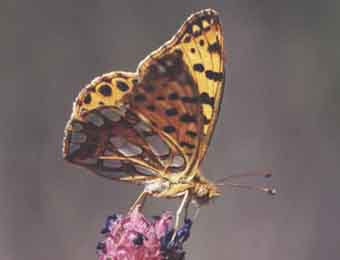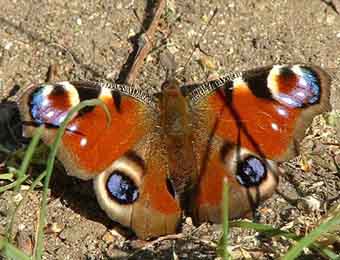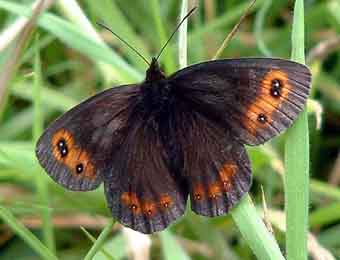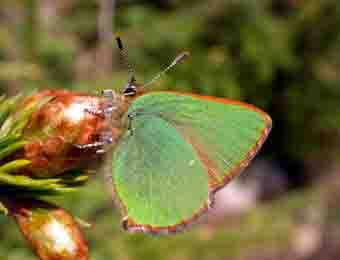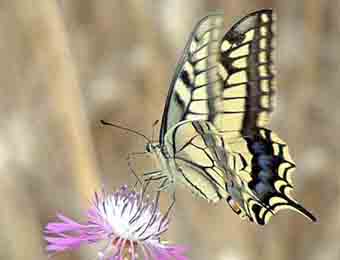|

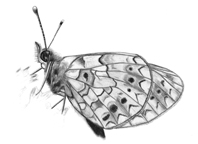
Ayrshire
Butterfly Report 1999
F
S Simpson
Introduction
The butterfly year of 1999 was another mixed bag for the 24 species recorded from March to November. While several of our common residents
such as the Whites and the Small Tortoiseshell were extremely thin on the ground (and in the air!), others did very well, particularly the Browns.
Migrants were scarce with only three Painted Ladies and a single Clouded Yellow and there were no influxes of Whites. Only the Red Admiral
showed signs of movements in reasonable numbers. Large Skipper, Wall Brown and Scotch Argus were all found in new areas.
Following low numbers of Small Tortoiseshells in 1998, it was perhaps not surprising that no early awakening was noted this year. However, the
fact that Ayrshire's first butterfly in 1999 was a Small White on 26 March was unbelievable. The first Tortoiseshell was noted on the 27th and
Peacock quickly followed on 1 April. Mid-April saw the main emergence of the last two species with an early Orange Tip in Ayr on the 18th.
Green-veined Whites were flying from the 24th but two Large Whites on the 30th were very early. The first week of May produced the first
Green Hairstreaks and Small Coppers although Red Admiral was not recorded until the 19th. Small Heath was noted on the 30th and in June,
several summer butterflies were first noted as follows: Wall (4th), Small Pearl-bordered Fritillary (8th), Northern Brown Argus (11th), Large
Skipper (11th), Common Blue (11th), Ringlet (17th), Meadow Brown (23rd), Dark Green Fritillary (24th), Grayling (24th). A Clouded Yellow on the
24th was obviously a highlight for one observer. In July, it became apparent that most of the Browns were experiencing an
excellent season. Large
Heath was first noted on the 5th, Scotch Argus from the 27th and Purple Hairstreak from the 29th. August revealed the extent to which Small
Tortoiseshell numbers had decreased and also the lack of great numbers of Whites. Only two Painted Ladies were reported this month.
September was generally a poor month as many species had either peaked earlier than usual or finished early. Red Admirals were reasonably
abundant particularly around the 25th with a steady southerly movement noted. The only other Painted Lady of the year was reported on the
25th. October held just three species and the final of the year was, not surprisingly, a Red Admiral on 7
November.
Systematic
List
Large Skipper Oclodes venata
STATUS: Locally common resident in southern Ayrshire - possibly expanding northwards.
FLIGHT PERIOD: June-July. Single generation.
The Large Skipper had a much better season in 1999 and the poor weather during its flight period last year appears to have had little effect on
well known colonies. The first were noted on 11 June at a coastal site south of Lendalfoot when 15 were already flying. Therefore, the
butterfly may have been on the wing for a few days previous. Single figures were reported throughout June at other southern coastal sites.
Hard work at the northern edge of its Ayrshire range paid off again this year when one was found in Sauchrie Glen in the Carrick Hills on 5 July.
This currently may be the most northerly site in the British Isles. Four were seen in the Changue Forest on 11 July when a top count of 24
was obtained in the Muck Water area. The latest reported was from a coastal site south of Lendalfoot on 18 July.
Dingy Skipper Erynnis tages
STATUS: Very rare resident - appears to be exclusively coastal.
FLIGHT PERIOD: Uncertain, but a period within May-Jun. Single generation.
No records were received for this moth-like species this year. This was despite extensive searching in the Girvan and Ballantrae areas (DG).
Clouded Yellow Colias croceus
STATUS: Rare migrant.
FLIGHT PERIOD: Appears Jun-Oct in two generations.
Following a good year in 1998, only one record was received. A single was observed in a garden in Wylie Crescent, Cumnock on 24 June.
Large White Pieris brassicae
STATUS: Fairly common resident and migrant - abundant in some years.
FLIGHT PERIOD: Late May-early Oct in two generations.
In a year that was generally poor for migrant species, the Large White was widespread but it was recorded in very small numbers. The butterfly
emerged extremely early, at least three weeks earlier than is typical, giving false hopes of a good year. Two females were observed at close
quarters on 30 April at Auchincruive, increasing to five by 4 May. Other early records included singles at Prestwick on 10 May, Bentfield on
13 May and on the disused railwayline between Knockentiber and Springside on 16 May, after which records were more widespread. The
most notable count of spring generation butterflies was obtained on the SOC trip to Ailsa Craig on 6 June. One observer counted 14
butterflies, while another estimated around 20+. The rest of the season was disastrous with counts of single figures until the end of August. The
peak period appeared to be during early to mid-August when eight were noted on the 10 at Doonfoot, seven on the 12th at Knockentiber, six
on the 20th at Maidens and four on 21st at Dipple. Singles were noted throughout September at a few localities. Final reports concerned singles
in Prestwick on 24 September and at Auchincruive on 5 October.
Small White Pieris rapae
STATUS: Common resident and migrant - abundant in some years.
FLIGHT PERIOD: Late Apr- early to mid Oct in two generations.
The pattern of occurrence of the Small White mirrored that of its larger relative. Numbers recorded were the lowest for many years, while
emergence was rather earlier. The first was reported on the shockingly early date of 26 March when a female approximately 75% typical size
was found at Auchincruive. This individual was flying around four weeks before most are expected (exception being emergence on 16 April
during the advanced spring of 1997) and was observed throughout April in the area of the gardens/playing fields until the 23rd. One possible
explanation that could account for this is that it may have emerged from a glasshouse where its development at the larval and pupal stages
could have been advanced by the effects of temperature and humidity. Elsewhere, first reports in April concerned one at Balkenna on 17th
followed by one at Bentfield, one at Knockentiber and three at Auchincruive on the 27th. Main emergence occurred from early May but reports
involved single figure counts. Interestingly, a "tiny male" was reported from Bentfield, Prestwick. The late summer generation did not improve, as
is usual, and although widespread, no double figure counts were reported anywhere during August. The species was notable by its general
absence in many areas during September, although one was still flying on 5 October at Auchincruive.
Green-veined White Pieris napi
STATUS: Resident - abundant in all suitable habitat.
FLIGHT PERIOD: Late Apr-late Sep in two generations
In comparison with the other Pierids, the Green-veined White had a relatively good season and was less affected by the factors which resulted
in their poor performance. Typically, emergence was well co-ordinated in lowland areas throughout the county with singles at Fenwick,
Prestwick and Finnarts Bay on 24 April. Three at Turnberry and singles at Maybole and Rowallan, Kilmarnock on the 26th followed these. Within
four days, more were on the wing than is usual for April and around 30 were flying at Maidens on the 30th. The species was reported as being
widespread along the south Ayrshire coast on 3 May. Counts of the first generation were relatively low, but peaked in mid-May and included
20 in the Changue Forest on 1 May. Numbers of second generation butterflies increased in July with 30 at Bentfield, Prestwick on the 12th, 20
at Blairbowie on the 23rd, 65 at Allanton Plans Wood on the 25th, 30+ at Shallochwreck Burn on the 29th, c150 at Ballantrae on the 30th and
50 at Bennane Lea on the 31st. Numbers remained high throughout August with the following counts received: 55 at Irvine Beach Park on the
1st, 633 at Cronberry slag bings on the 6th, 79 in the Changue Forest on the 8th and 42 at Currarie Port on the 21st. Populations dropped in
September and the final record involved on at Knockentiber on the 25th.
Orange-tip Anthocharis cardamines
STATUS: Fairly common resident and possible migrant - range expanding annually.
FLIGHT PERIOD: Late Apr-late Jun. Single generation.
The Orange Tip had a satisfactory season in 1999 and, like the above species with which it shares certain ecological characteristics, was flying
in higher numbers than is usual for April. A male was reported from Knoll Park, Ayr on 18 April was around 10 days earlier than normal and
constitutes the second earliest in the last seven years. The next two were at Auchincruive on the 23rd, followed by five at Townholm,
Kilmarnock on the 27th and six at Auchincruive on the 30th. Numbers peaked in early May and the largest counts were of 17 in the Changue
Forest on the 1st and 20 on the disused railwayline between Knockentiber and Springside on the 16th. Very few records were received for the
month of June and the season closed with one at Townholm, Kilmarnock on the 14th.
Green Hairstreak Callophrys rubi
STATUS: Locally common resident in suitable habitat, particularly upland forestry edge.
FLIGHT PERIOD: Late Apr-Jun. Single generation.
In common with other spring emerging butterflies, this species appeared to be flying in peak number at least a week earlier than usual. As a
result, peak counts were missed from several of the larger and well known colonies. However, it appeared to do reasonably well. To illustrate
this point, this first record concerned 21 on 1 May in the Changue Forest followed by 42 at Craigendunton Reservoir on the 2nd. Counts
received included seven in Glen App on the 3rd, seven on Fairlie Moor on the 11th and eight in Fairlie Glen, also on the 11th. Only 10 were found
at Corsehouse Reservoir in the 15th. The latter site also provided the final sighting of the season with a single on 6 June.
Purple Hairstreak Neozephyrus quercus
STATUS: Scarce resident in Oak woodlands in South Ayrshire - locally common.
FLIGHT PERIOD: Uncertain, but a period within mid Jul-early Sep. Single generation.
Much searching of both well known and new areas found that this elusive insect had a poor year. It was first seen in late July with three at the
largest known colony south of Ballantrae on the 29th. Three more were observed in the Finnarts Bay area on the 31st. Regular visits to the
Ballantrae colony by a few observers during August yielded either none at all or just singles in what were perfect weather conditions. The last
was noted here on 21 August.
Small Copper Lycaena phlaeas
STATUS: Common and widespread resident.
FLIGHT PERIOD: Mid May- Oct in two generations. A third generation in good years.
After an apparently poor season last year, the butterfly performed slightly better but it would appear that its occurrence is reverting back to
that seen in the early 1990's before the range expansion observed around the middle of the decade. The majority of records came from coastal
areas but this may reflect a bias in observer coverage. Emergence was early again this year with one at Bentfield, Prestwick on 7
May - the
same site as last year's first report. Two at Turnberry Point and one at Knockentiber on the 16th with four at Bentfield on the 19th followed
this. First generation numbers were low and the highest count was of nine at Shaw Bridge, Kilmaurs. The first of the second generation was
noted on 18th July at Gailes where the following counts were made over the rest of the season: 102 on the 1 August; 27 on the 21st; 11 on
the 28th; four on 9th September. Elsewhere, records of single figure counts came from mainly coastal areas. A total of 16 were counted at
Irvine Beach Park on 16 August and nine were at Currarie Port on the 21st. An aberrant specimen of the form caeruleopunctata was observed
on the coast south of Dunure on 22 August. Few were reported during September and the season appeared to be over fairly early with the final
two at Turnberry GC on the 26th. This was the first year that no October records were received.
Northern Brown Argus Aricia artaxerxes
STATUS: Scarce resident - exclusively coastal in central and southern Ayrshire.
FLIGHT PERIOD: Jun-early Aug. Single generation.
The Northern Brown Argus fared much better in 1999 despite poor weather during it flight period last year. The first were reported on 11 June
with six at a site north of Lendalfoot and nine at a site south of Lendalfoot. Butterflies were reported throughout June at these two sites
including five at Balsalloch, near Lendalfoot. The best count of the season was obtained on 24 June with 10 at the site north of Lendalfoot.
Smaller numbers were flying in July. The final report concerned a single at a new site with one at Currarie on 30 July.
Common Blue Polyommatus icarus
STATUS: Locally common resident - abundant in some years.
FLIGHT PERIOD: Jun-Oct in one generation. A partial second brood in good years.
A similar year to 1998 with reasonable numbers particularly in coastal locations.
First records were fairly early with two at a coastal site south of Lendalfoot and two at a coastal site north of Lendalfoot on 11 June. These
were followed by one at Knockentiber on the 15th and one at Balsalloch on the 17th. The main emergence occurred in late June. Peak numbers
were flying in July and early August and the following counts were notable: 22, Gailes, 9 July; 22, Changue Forest, 11 July; 34, Gailes, 12
July; 100+ at Gailes on 18 July (including a high proportion of females which are normally less visible); 18, Troon Harbour, 30 July; 18, Irvine
Beach Park, 30tJuly; 36, Gailes, 1 August. As with many other species, few were reported in September but the final record involved a fresh
male at Stevenston Point on 22 September.
Red Admiral Vanessa atalanta
STATUS: Migrant in variable numbers - a few possibly overwinter.
FLIGHT PERIOD: Apr-Nov. Single generation.
Normally present in good numbers, this migrant was relatively scarce during the spring and summer. Numbers were better in the autumn when
reasonable numbers and movements of butterflies were noted. The spring provided just four records of seven individuals as follows: one near
Hurlford on 19 May; one in Kilmarnock on 1 June; four at Whinfield Rd, Prestwick and one at Kilwinning on 4 June. The next run of records
began on 27th June through to mid-September but involved sightings of one or two individuals at any location. Numbers began to build from
mid-September when seven were observed flying in off the sea at Portencross on the 19th, followed by nine at Turnberry Point on the 21st, 14
at Ayr College and 11 at Darconner on the 22nd. On 22 September, a steady southerly movement was evident through central Ayrshire. At
least 154 were present at Stevenston Point the same day, nectaring mainly on Michaelmas daisies (Aster novi-belgii), and a steady passage
south of around 30-40 individuals/hour was noted here. On 23rd September, five were observed together on a tree trunk in Howard Park,
Kilmarnock. The butterfly was widespread throughout September and October and the following counts were received: 50+, Bentfield on 24
September; 150, 25-30 September in the Monkton area; 27, Turnberry GC on 25 September and 104, in the orchard at Auchincruive on 5
October. By mid-October, numbers dropped rapidly although most observers reported several on the 24th at Ladykirk, Kilmarnock, Barassie,
Troon, Prestwick and Ayr. At Auchincruive, one individual hung on into November and was last seen in the orchard on the 7th.
Painted Lady Vanessa cardui
STATUS: Irregular migrant - usually in small numbers.
FLIGHT PERIOD: Apr-Oct. Single generation.
In line with the national picture, 1999 was a poor year for the Painted Lady in Ayrshire. Just three records of three individuals were reported in
late summer as follows: one at Maryborough Road railway bridge; Ayr between 4 and 12 August; one at Cronberry slag bing on 6 August;
one on the disused railwayline at Knockentiber on 25 September.
Small Tortoiseshell Aglais urticae
STATUS: Common and widespread resident and migrant - overwinters.
FLIGHT PERIOD: Mar-Oct/Nov. Single generation.
Following a poor season last year, the performance of this common butterfly decreased further and it would appear that numbers are returning
to the 'lows' of the early 1990's. The reason for this periodic fluctuation in numbers over the last decade may be due to minor climatic
variations. Following just a single March record involving one in Prestwick on the 27th, a widespread emergence was noted on 1 April with
sightings from Knockentiber, Auchincruive, Prestwick, Townholm, Kilmarnock and Girvan. Most butterflies would appear to have left hibernation
around mid-April when the highest spring counts were received: 16 on the disused railwayline at Knockentiber on the 17th (most nectaring on
dandelions, Taraxacum spp.); 84 in Townholm on the 27th; 12 at Knockentiber on the 27th and 10 at Martnaham on the 27th. Interestingly, one
was still flying at Northcraig Reservoir at 1940h on 27 April. Reports continued through May until early June but all were of single figure counts.
The first fresh offspring from overwintering butterflies was noted very early when a single was found in Maryborough Road, Ayr on 6 July. By
late July, most began to emerge with five at Blairbowie on the 23rd, seven at Knockentiber on the 26th and nine at a coastal site north of
Lendalfoot on the 31st. Although widespread, it was difficult to find the species in reasonable numbers anywhere. The best counts in August
were as follows: 34, Knockshinnoch on the 6th; 47, Knockshinnoch on the 13th and 14, Springbank Mine on the 19th. Single butterflies were
reported throughout September. October provided a single record of one in Prestwick between the 23rd and 27th.
Peacock Inachis io
STATUS: Scarce resident and possible migrant - overwinters.
FLIGHT PERIOD: Mar-Oct. Single generation.
Still widely reported following its range expansion in the mid 1990's, the Peacock occurred in good numbers, particularly in the south of Ayrshire.
The first individuals to leave hibernation were noted on 1 April when three were found nectaring on dandelion in Townholm, Kilmarnock.
However, it was not until mid-month that a widespread emergence was noted with records from Finnarts Bay, Knockentiber, Prestwick, Crosshill,
Fisherton and the Heads of Ayr. Peaks numbers were flying in early May but in single figures, e.g. five in the Changue Forest on the 1st and five
at Finnarts Bay on the 3rd. No individuals persisted into June. Five freshly emerged second generation butterflies were at Bennane Lea on 31
July. Thereafter, the main emergence occurred and large numbers were found in the south on 8 August: 41 in the Changue Forest; 70 in the
Arecleoch Forest; 86 between Dornal and Barjag. Elsewhere, the butterfly was widespread but reported in single figures until early September.
The last individual was noted at Turnberry Golf Course on 26 September.
Small Pearl-bordered Fritillary Boloria selene
STATUS: Resident - locally common in the south, scarce in the north.
FLIGHT PERIOD: Late May-Jul. Single generation.
This butterfly had another good season although numbers were slightly lower than last year. The first were noted on the rather late date of 8
June when two were found at Glenbay in the Carrick Hills. These were followed by 15 at a coastal site south of Lendalfoot on 11 June. Peak
numbers were flying by late June and most reports came from the south of the county. Six were reported from Gala Lane on 25 June and 26
were flying at a site near Loudoun Hill on the 26th. In July, five were present at Glenbay on the 5th, three in the Changue Forest on the 11th
and 41 in the Muck Water area on the 11th. The final report was of three at the Loudoun Hill site on 25 Jul.
Dark Green Fritillary Argynnis aglaja
STATUS: Resident - locally common in southern and central areas - scarce in the north.
FLIGHT PERIOD: Jun-Aug. Single generation.
The Dark Green Fritillary had a similar season to last year when some good sites produced low counts whereas at other sites, quite healthy
populations were noted. Late June provided the first record with a single butterfly at a site south of Lendalfoot on the 24th. Good numbers were
recorded in the Carrick Hills in early July with nine at Glenbay and 31 in Sauchrie Glen on the 5th. The Gailes site held low numbers again this
year, the peak count being nine on 1 August, however, 10 were flying nearby in a small area of Irvine Beach Park. The season closed with two at
Gailes on 15 August.
Wall Brown Lasiomatta megera
STATUS: Resident - very local in central and southern areas - predominantly coastal.
FLIGHT PERIOD: Late May-Sep in two generations.
As with the rest of the Browns, the Wall had a very good season with records from many southern coastal areas. First generation individuals
were not reported until as late as 5th June when two were found in Glen App. The 6th produced an interesting record of a male on Ailsa Craig -
the first in the history of the report. The highest count of first brood individuals was of five at Portandea on 10 June. The second brood was
on the wing by the end of July when a single was noted a coastal site north of Lendalfoot on the 29th. Numbers began to peak from mid-August
with 10 at a coastal site south of Lendalfoot on the 20th, six at Ballantrae Castle on the 20th and 24 at Currarie Port on the 21st. The butterfly
was also recorded from a new area on the 20th when one was at Balnowlart near Lendalfoot. Following a record from the Dunure area in 1993,
another was found this year on the coast just south of the village on 22 August. No more reports were received after late August but the
butterfly was presumably on the wing well into September.
Scotch Argus Erebia aethiops
STATUS: Resident - abundant in southern Ayrshire - rare in central and northern areas.
FLIGHT PERIOD: Late Jul-Aug. Single generation.
The Scotch Argus is the latest of Ayrshire's butterflies to emerge and in 1999 the first report was of 18 at Clawfin, Dalmellington on 27 July.
By early August, the species was flying in huge numbers with 274 counted along a four-mile stretch of forest track at Dalmellington on the 6th.
One unlucky individual here was taken in flight by a Golden-ringed Dragonfly (Cordulegaster boltonii). On the 8th, the Scotch Argus was
innumerable in certain areas with hundreds in the Barr and Dornal areas and in the Arecleoch Forest. A circular trail of the Changue Forest the
same day produced a count of 376. Among them was a very dark specimen lacking any eyespots and orange patches and was of the aberrant
form nigra or obsoleta. Good numbers were also reported from the Stinchar Bridge and Tairlaw Toll areas in August. On the 20th, an interesting
find was of four butterflies at a coastal location south of Lendalfoot, representing the first coastal record of this species in Ayrshire. They were
at least 8km from the nearest inland colonies and this record provides evidence of local migration. This also represented the final record of the
year and the season probably finished within a few days.
Grayling Hipparchia semele
STATUS: Resident - fairly common in suitable coastal habitats - scarce inland.
FLIGHT PERIOD: Late Jun-mid Sep. Single generation.
The summer of 1999 was one of the best of the last seven years for the largest of the Satyrids. Widely reported in suitable habitat along the
entire stretch of the Ayrshire coastline, record counts were reported at well known sites. The first of the year was reported from a coastal site
north of Lendalfoot on 24 June. The main emergence occurred from the beginning of July. Interestingly, one was found inland at Kilwinning
station, possibly having worked its way along the railwayline from the coast. At another new inland location, one was observed at Springbank
Mine on 1 July. Large numbers were flying thought July and August and included the following high counts: 91, Moorfield, Kilmarnock on 8
July; 86, Turnberry on the 9th; 127, Moorfield, Kilmarnock on the 12th; 41, Troon Harbour on the 30th; 152, at a coastal site north of
Lendalfoot on the 31st; 176, Irvine Beach Park on 1 August; 29, Currarie Port on 21 August. Even areas which normally hold very few did
well, e.g. 10 at Bentfield, Prestwick on 12 July. By late August, numbers had decreased considerably and the season finished with four at
Troon Harbour on 9 September.
Meadow Brown Maniola jurtina
STATUS: Common and widespread resident.
FLIGHT PERIOD: Late Jun-Sep. Single generation.
The Meadow Brown did well in 1999 and was seen in reasonably good numbers, particularly in coastal areas. With the exception of 1997, the last
seven years have seen this butterfly time its emergence to near perfection, with regards to the date, whatever the weather conditions in late
June. Singles at Auchincruive on the 23rd and Knockentiber on the 24th were followed by three at Bentfield, Prestwick on the 25th. By early
July, a general emergence was noted with 21 at Sauchrie Glen on the 5th, 24 at Moorfield on the 8th and 93 at Springbank Mine on the 8th. One
was observed flying in evening sunshine at 2045h on the disused railwayline between Knockentiber and Springside on the 8th. The species
appeared to be flying in peak numbers mid to late month with 113 at Gailes on the 12th, 179 at Kilmarnock Tip on the 12th, 100+ at Bentfield on
the 12th and 201 at Troon Harbour/Marina on the 30th. At least 98 were counted at Gailes on 1 August. After the first week of August it
became quite scarce and was widespread only until the 21st of the month. September produced a single record of two at Bentfield on the 4th -
an extremely early finish to the Meadow Brown's season.
Small Heath Coenonympha pamphilus
STATUS: Common and widespread resident.
FLIGHT PERIOD: Jun-Sep. One generation - possibly two in lowland areas.
While this butterfly was not recorded in high numbers like the other browns, it was widely reported with some reasonable counts. The species
emerged on 30 May with singles at Shenas and Drumbracken and a week later a large emergence was apparent. At Glenbay, 23 were counted
on 8 June, followed by 35+ at Portandea on the 10th. Peaks numbers were evident in July, with 42 at Glenbay on the 5th, 64 at Gailes on the
9th, and 100+ at Gailes on the 18th. The butterfly was widely reported throughout July and in early August the butterfly was still common with
44 at Irvine Beach Park and 78 at Gailes on the 1st. Numbers declined in mid-August and no reports were received after the 11 at Gailes on the
21st.
Large Heath Coenonympha tullia
STATUS: Resident - not uncommon on boggy, moorland habitat. Under-recorded.
FLIGHT PERIOD: Jun-Jul. Single generation.
Typically, few reports were received for this species due to the nature of its habitat and distribution. Emergence was noted from 5 July when
three were found at Red Moss Loch. A survey of the Muck Water area on the 11th revealed at least 25 flying. One was noted at Corsencon
Limekilns on the 11th followed by two at Loch Bradan on the 12th. The second August record in the Report's history was received when a single
was still flying at Cronberry on the 6th.
Ringlet Aphantopus hyperantus
STATUS: Resident - common on central and southern areas - rare in the north.
FLIGHT PERIOD: Mid/late Jun - mid Aug. Single generation.
Another of the browns to experience an excellent season, 1999 was probably the best year in the history of this report. The butterfly was on
the wing in considerable numbers by late June and by mid-July, southern Ayrshire was alive with Ringlets. Balsalloch, near Lendalfoot, produced
the first on the 18th followed by four at Springbank Mine on the 23rd, 10 at a coastal site north of Lendalfoot on the 24th. Within a few days
there was a large-scale emergence with 74 at Mauchline Pit on the 27th, 40 at Springbank Mine on 1 July and 63 at a site south of Lendalfoot
on 3 July. Largest counts in central Ayrshire were 67 in Sauchrie Glen on 5 July and 63 at Auchalton SWT on 8 July. One at Moorfield,
Kilmarnock on 8 July was north of its typical range showing evidence of local movements when populations are high. A very small coastal site
north of Lendalfoot saw 61 on 10 July. On 11 July in southern areas, the butterfly was extremely numerous and 509 were counted on a
circular trail of the Changue Forest. A count in the Muck Water area on the same day produced a total of a least 223. After such early peak
numbers, the season finished early although eight were still in the Changue Forest on 8 August.
Many thanks are due to everyone who has contributed reports and helped to establish an important atlas of records
List
of contributors
Many thanks to the following contributors for providing records for the 1999 report:
Dr. J P Black, S Fisher, D Given, R H Hogg, J McGrady, D J Murphy, A Simpson, F Simpson, R G Vernon.
For
details of the latest Ayrshire Butterfly Report - click
here
A-Z
Index |
Search
this Website
| Links |
Ayrshire
Bird Report
| Ayrshire
Winter Bird Race | Scarlet
Banded-Barbet
| Blog
Index
|
|

